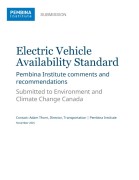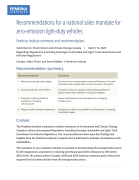On behalf of the Pembina Institute, analyst Cedric Smith made the following submission to the House of Commons Standing Committee on Environment and Sustainable Development on November 23, 2020:
Chair and committee members, thank you for the invitation to take part in your consultations on Zero Emission Vehicles (ZEV).
Today I am here to talk to you about ZEVs and Canada's climate commitments. Under the Paris Agreement, Canada has committed to reducing GHG emissions by 30 per cent below 2005 levels as of 2030. More recently, Canada has set a target of net-zero by 2050. Only last week, Canada introduced Bill C-12, an Act respecting transparency and accountability in Canada's efforts to achieve net-zero greenhouse-gas emissions by the year 2050. Reducing emissions from transportation — which make up a quarter of Canada’s total emissions and have increased significantly over the past two decades — is necessary to meet these targets.
Pembina views an accelerated transition to ZEVs as key to Canada decarbonizing its transportation sector. Recent analysis by the International Energy Agency (IEA) indicates that achieving net-zero greenhouse gas emissions as of 2050 would require that over 50 per cent of passenger cars sold be electric as of 2030. Canada has set a non-binding target of ZEVs making up 10 per cent of new light-duty vehicles sold as of 2025, 30 per cent as of 2030 and 100 per cent as of 2040. Without further action, Canada is unlikely to meet either target. Currently, ZEVs make up only about 3 per cent of the market.
There are three major barriers to further ZEV adoption in Canada — high upfront purchase prices, insufficient charging and refueling infrastructure and insufficient supply. Targeted policy action can help tackle these barriers:
Purchase incentives
ZEVs have higher upfront purchase prices than traditional internal combustion engine vehicles. Estimates by the ICCT, for example, indicate that the differential is $10,000 for short-range cars and $27,000 for long-range SUVs.
Canada's iZEV program provides point-of sale incentives for the purchase or lease of zero-emission vehicles, with a maximum incentive amount of $5,000. The program has been allocated $300 million for three years, beginning in 2019-20. Uptake in Year 1 of the program suggests iZEV could run out of money in Year 2 without additional funding. iZEV should be topped up by $150 million in the next federal budget.
Funding for charging and refueling infrastructure
“Range anxiety” refers to a fear by owners of internal combustion engine (ICE) vehicles that ZEVs will run out of power on a trip. Such fear is often noted as a barrier to ZEV ownership. It is also important that ZEV adopters be able to charge their vehicles at home – the majority of early adopters have home access to charging infrastructure.
Unfortunately Canada’s public ZEV charging network remains limited with under 4,500 charging stations comparing unfavorably with over 12,000 gasoline stations. In addition, about one third of Canadians live in multi-unit residential buildings (MURBS) (ex: apartment buildings) or are “garage orphans” (residing in dwellings with no access to garages or driveways) and face unique difficulties with home charging.
Canada’s Zero Emission Vehicle Infrastructure Program (ZEVIP) has been funded with $130 million over five years, beginning in 2019, to fund the deployment of electric vehicle infrastructure in public settings – including on-street and parking areas – as well as for multi-unit residential buildings. To scale up the program and increase the funding contribution, ZEVIP should be topped up by $300 million in the next federal budget.
Adoption of a zero-emission vehicle standard
Finally, Canada has an issue with electric vehicle supply. According to recent research, only one of three dealers in Canada have at least one plug-in electric vehicle (PEV) in stock. This figure decreases to less than one in five for dealers outside of Ontario, British Columbia and Quebec.
The implementation of a light-duty zero-emission vehicle standard would help increase supply in Canada. Such a standard would require that an increasing portion of auto manufacturer vehicle sales be zero-emission. Quebec, which has a mandate in place, makes up about 57 per cent of Canada's PEV inventory. Since the adoption of Quebec’s ZEV Act in 2016, the percentage of ZEV models available in California that are also available in Quebec increased from 66 per cent to 92 per cent.
It should be noted that, in addition to greenhouse gas reduction benefits, increased ZEV sales will also create economic benefit for Canada as manufacturers benefit from an expanded domestic market. Globally, the majority of electric vehicles (80 per cent) are produced in the same region they are sold.
Canada has, in the past, lagged behind in the transition to an electrified transportation future. In 2018, for example, the electric share of Canada’s vehicle production was 80 per cent lower than the global average. Recently, however, there have been announcements of auto-maker investments into EV manufacturing – including $1.8 billion to retool the Ford Oakville Assembly Complex to produce battery electric vehicles. An expanded Canadian ZEV market will only accelerate this positive momentum.
Targeted policy — including purchase incentives, funding for charging and refueling infrastructure, and a zero-emission vehicle standard — can help increase zero-emission vehicle sales and help Canada meet its climate targets. In doing so, economic benefit will be derived for Canadians as well.
Download the submission for the full text and sources.






